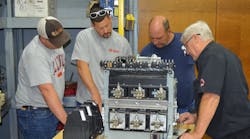Refresher Training: The Key to Safeguarding Your Electrical Workforce
Electrical workers participate in rigorous on-the-job and classroom training in the early years in the trade. Over the decades, as they become more seasoned, they may receive less training as they progress in their careers.
Here are five reasons why utilities should consider investing in refresher training for their field workforce, according to Tom Norwood, manager of instructors for AVO Training Institute.
1. Reduce the rate of injuries and fatalities. From 1992 to 2012, the electrical industry reported 6,000 fatalities from electrical injuries. “Electricity that is misused or abused can cause fatalities,” Norwood says. “We must understand that electricity is volatile and can cause issues or death.”
About 98 percent of the fatalities associated with electricity are from shock, and half of those killed by shock in the electrical environment are not electrical workers. As such, utilities must train not only qualified, but also unqualified, personnel about the how to stay safe in an electrical environment.
2. Understand the hazards faced by electrical workers. Before developing a safety program, utilities must first perform an assessment of hazards in the workforce. For example, they must assess the risk of electrical shock and arc flash exposure.
The extremely high temperatures during an arc flash event can inflict serious injuries to employees by vaporizing metal, igniting clothing and causing severe skin burns to employees—whether or not they are qualified electrical workers.
3. Invest in the proper personal protective equipment (PPE). Once electrical companies have developed their assessments, they can develop a program wrapped around these hazards. They can also identify training needs and pinpoint which PPE to invest in to protect their workers from hazards.
According to OSHA, lack of PPE, along with improper lockout/tagout procedures are the primary two causes of electrical injuries. Retraining is essential to re-enforce the need to use appropriate PPE. Over the years, however, the number of injuries stemming from these two factors, has declined due to an increased emphasis on employee training. Also, electrical companies are investing in different levels of equipment like low-voltage gloves, arc flash face shields and flame-retardant shirts, pants and coveralls to protect their workers.
4. Keep up with changes in procedures and technologies. Employers are mandated to determine, through regular supervision, that their employees are incorporating safe work practices. If their job responsibilities change, they must be retrained on how to perform new tasks and have access to the PPE to perform their jobs safely. For example, if they haven’t performed a specific job within one year, they may no longer be qualified to do the task and need some retraining.
“You can’t just give them the manual and tell them to go work on a piece of equipment,” Norwood says. “There may be additional hazards or serious issues they may face.”
For example, if an employee focused on working on systems 240 V or less, and then was shifted into a new department, he or she may not be qualified to work in the new environment without additional training.
“In the electrical industry, there are changes in responsibilities and equipment,” Norwood says. “It’s not uncommon to have a new product line where you change out old equipment with new equipment. This brings on new hazards, and you have to deal with them differently.”
Also, with NFPA 70E changing every three years, electrical companies must ensure that they are up-to-date on the latest regulations and standards on work procedures and PPE for their electrical workforce.
5. Eliminate unsafe work practices. The number of non-fatal injuries from 1992 to 2016 has steadily declined from 6,000 in 1994 to 1,640 in 2016. Even so, younger workers may be taught by older employees in inappropriate work procedures, such as wearing leather gloves to work on energized conductors.
“One of the reasons it’s necessary to have some level of retraining for employees on a regular basis is to remind them that the training that they had originally received may not be appropriate and may not guard their safety,” Norwood says. “They may have to change the way they do things.”
Electrical safety training must be ongoing due to multiple factors. For example, both work environments and PPE are constantly changing, Norwood concluded.
“The future is now, and we need to make sure we understand the changes in our workers’ responsibilities, equipment and procedures,” he says. “Retraining will address any of these changes.”
AVO Training Institute offers more than 57 electrical training courses accredited by the International Association for Continuing Education and Training and 12 electrical certification programs. Learn more at www.avotraining.com.
Sponsored By:




